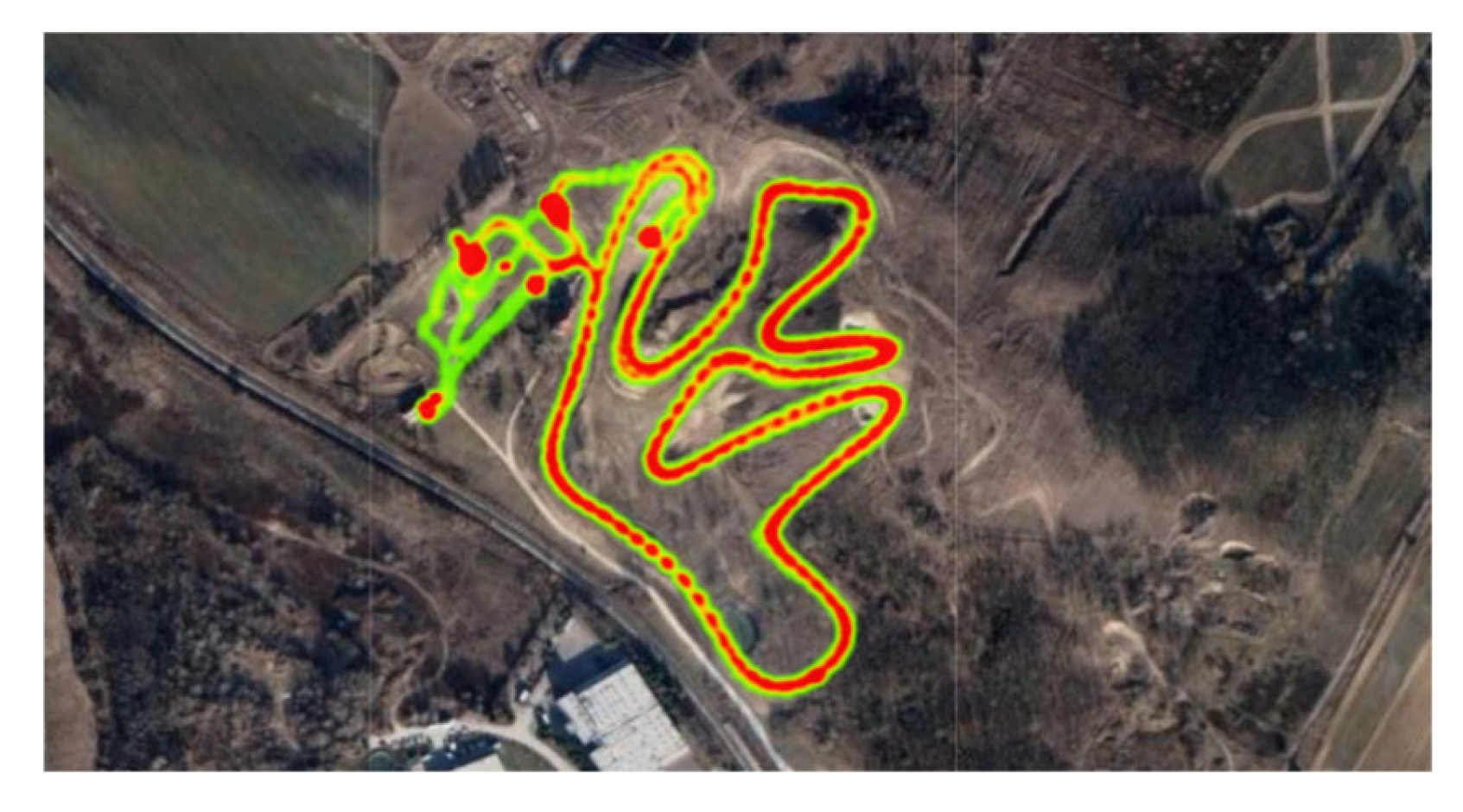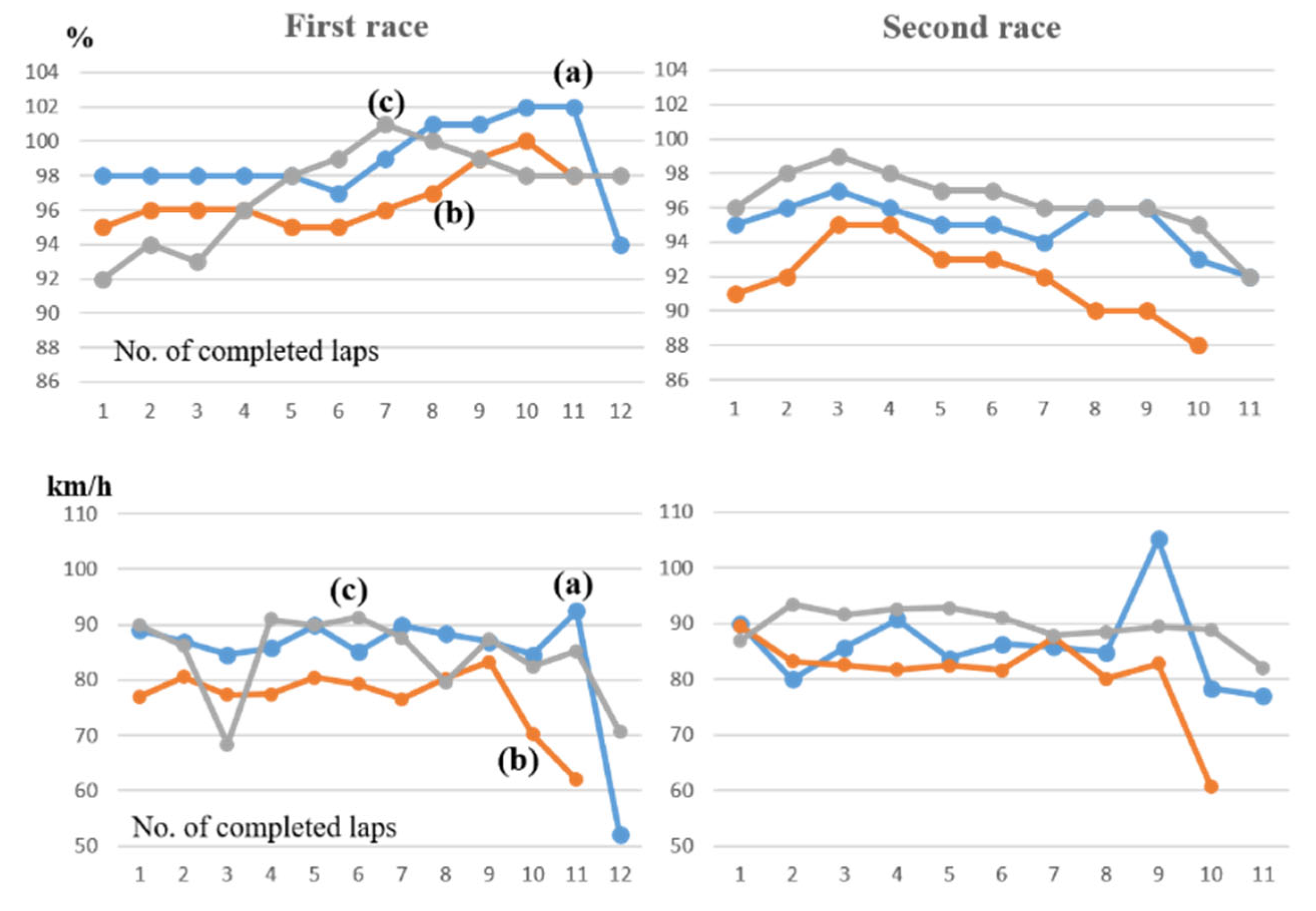Analysis of the Laboratory and In-Competition Characteristics of Adolescent Motocross (MX) Riders: An In Situ Case Study
Abstract
:1. Introduction
2. Materials and Methods
2.1. Subjects
2.2. Anthropometry and Body Composition
2.3. Examination of the Circulatory and Respiratory Systems
2.4. Measurements during the Race (Polar Team Pro)
2.5. Examination of the Strength of Both Bilateral Hamstring and Extensor and Abductor Muscles
3. Results
3.1. Laboratory Tests
3.2. Field Tests
4. Discussion
5. Limitations
6. Future Research
Author Contributions
Funding
Institutional Review Board Statement
Informed Consent Statement
Data Availability Statement
Acknowledgments
Conflicts of Interest
References
- MotoGPTM Reaches Record Global TV Coverage for 2015. MotoGP News. 2015. Available online: http://www.motogp.com/en/news/2015/03/26/motogp-reaches-record-global-tv-coverage-for-2015/172335 (accessed on 1 April 2017).
- Bach, C.W.; Brown, A.F.; Kinsey, A.W.; Ormsbee, M.J. Anthropometric characteristics and performance capabilities of highly trained motocross athletes compared with physically active men. J. Strength. Cond. Res. 2015, 29, 3392–3398. [Google Scholar] [CrossRef] [PubMed]
- Konttinen, T.; Häkkinen, K.; Kyröläinen, H. Cardiorespiratory and neuromuscular responses to motocross riding. J. Strength Cond. Res. 2008, 22, 202–209. [Google Scholar] [CrossRef] [PubMed]
- Szczepan, S.; Błacha, R.; Brożek, T.; Zatoń, K. Seasonal Changes in Force Production Accuracy as a Measure of Kinesthesia in Motorcyclists. Hum. Mov. 2020, 21, 15–21. [Google Scholar] [CrossRef]
- D’Artibale, E.; Laursen, P.B.; Cronin, J.B. Human Performance in Motorcycle Road Racing: A Review of the Literature. Sports Med. 2018, 48, 1345–1356. [Google Scholar] [CrossRef]
- Baur, H.; Muller, S.; Hirschmuller, A.; Huber, G.; Mayer, F.; Klarica, A. Reactivity, stability, and strength performance capacity in motor sports commentary. Br. J. Sports Med. 2006, 40, 906–911. [Google Scholar] [CrossRef] [PubMed]
- Ascensão, A.; Azevedo, V.; Ferreira, R.; Oliveira, E.; Marques, F.; Magalhães, J. Physiological, biochemical, and functional changes induced by a simulated 30 min off-road competitive motocross heat. J. Sports Med. Phys. Fitness 2008, 48, 311–319. [Google Scholar]
- Kerner, L.; Katona Zs, B.; Suszter, L.; Barthalos, I.; Ihász, F.; Podstawski, R. Anthropometric and physiological characteristics of young elite Hungarian motocross riders in motocross competitions. Phys. Act. Rev. 2024, 12, 47–58. [Google Scholar] [CrossRef]
- Salstin, B. Motocross-ajajan maksimaalinen hapenottokyky ja syketaajuus ajosuorituksen aikana. (Maximal oxygen uptake and heart rate during motocross riding). In Husqvarna 250-360 CR. Owner’s Manual, American Edition; Husqvarna: Värnamo, Sweden, 1975. (In Swedish) [Google Scholar]
- Lehmann Von, M.; Huber, G.; Schaub, F.; Keul, J. The significance of the catecholamine excretion for the evaluation of the physical and emotional stress in motocross drivers. Dtsch. Z. Sportmed. 1982, 33, 326–336. (In Germany) [Google Scholar]
- D’Artibale, E.; Tessitore, A.; Tiberi, M.; Capranica, L. Heart rate and blood lactate during official female motorcycling competitions. Int. J. Sports Med. 2007, 28, 662–666. [Google Scholar] [CrossRef]
- Schwaberger, G. Heart rate, metabolic and hormonal responses to maximal psycho-emotional and physical stress in motor car racing drivers. Int. Arch. Occup. Environ. Health 1987, 59, 579–604. [Google Scholar] [CrossRef]
- D’Artibale, E.; Tessitore, A.; Capranica, L. Heart rate and blood lactate concentration of male road-race motorcyclists. J. Sports Sci. 2008, 26, 683–689. [Google Scholar] [CrossRef] [PubMed]
- Filaire, E.; Filaire, M.; Le Scanff, C. Salivary cortisol, heart rate and blood lactate during a qualifying trial and an official race in motorcycling competition. J. Sports Med. Phys. Fitness 2007, 47, 413–417. [Google Scholar] [PubMed]
- Tsopanakis, C.; Tsopanakis, A. Stress hormonal factors, fatigue, and antioxidant responses to prolonged speed driving. Pharmacol. Biochem. Behav. 1998, 60, 747–751. [Google Scholar] [CrossRef] [PubMed]
- Ascensão, A.; Ferreira, R.; Marques, F.; Oliveira, E.; Azevedo, V.; Soares, J. Effect of off-road competitive motocross race on plasma oxidative stress and damage markers. Br. J. Sports Med. 2007, 41, 101–105. [Google Scholar] [CrossRef] [PubMed]
- Del Rosso, S.; Abreu, L.; Webb, H.E.; Zouhal, H.; Boullosa, D.A. Stress markers during a rally car competition. J. Strength Cond. Res. 2016, 30, 605–614. [Google Scholar] [CrossRef]
- ISO 13485:2016; Medical Devices—Quality Management Systems—Requirements for Regulatory Purposes. ISO: Geneva, Switzerland, 2016.
- Johnson, R.L., Jr. Gas exchange efficiency in congestive heart failure. Circulation 2000, 101, 2774–2776. [Google Scholar] [CrossRef]
- Ponikowski, P.; Chua, T.P.; Anker, S.D.; Francis, D.P.; Doehner, W.; Rauchhaus, M.; Coats, A.J.S. Peripheral chemoreceptor hypersensitivity: An ominous sign in patients with chronic heart failure. Circulation 2001, 104, 544–549. [Google Scholar] [CrossRef]
- Beaver, W.L.; Wasserman, K.; Whipp, B.J. A new method for detecting anaerobic threshold by gas exchange. J. Appl. Physiol. 1986, 60, 2020–2027. [Google Scholar] [CrossRef]
- Takano, N. Respiratory compensation point during incremental exercise as related to hypoxic chemosensitivity and lactate increase in men. Jpn. J. Physiol. 2000, 50, 449–455. [Google Scholar] [CrossRef]
- White Paper. Polar Team Pro System Polar Research Center.March 11, 2022, Page 1:(7). VAT FI02099112, Domicile: Kempele. Available online: www.polar.com/en/img/static/whitepapers/pdf/polar-team-pro-white-paper.pdf?srsltid=AfmBOoquWdQqXJoPTNutr6vyI0gK8ch4el6o5k580gC-ipixK7yJFo3K (accessed on 12 February 2023).
- Kadlec, D.; Jordan, M.J.; Snyder, L.; Alderson, J.; Nimphius, S. Test Re-test Reliability of Single and Multijoint Strength Properties in Female Australian Footballers. Sports Med. 2021, 7, 5. [Google Scholar] [CrossRef]
- Jacobs, P.L.; Olvey, S.E. Metabolic and heart rate responses to open-wheel automobile road racing: A single-subject study. J. Strength Cond. Res. 2000, 14, 157–161. [Google Scholar] [CrossRef]
- Collins, D.; Doherty, M.; Talbot, S. Performance enhancement in motocross: A case study of the sports science team in action. Sport Psychol. 1993, 7, 290–297. [Google Scholar] [CrossRef]
- Konttinen, T.; Häkkinen, K.; Kyröläinen, H. Cardiopulmonary loading in motocross riding. J. Sports Sci. 2007, 25, 995–999. [Google Scholar] [CrossRef] [PubMed]
- Magalhaes, J.; Ferreira, R.; Marques, F.; Oliveira, E.; Soares, J.; Ascensão, A. Indoor climbing elicits plasma oxidative stress. Med. Sci. Sports Exerc. 2007, 39, 955–963. [Google Scholar] [CrossRef] [PubMed]
- Garcia-Mata, S. Chronic exertional compartment syndrome of the forearm in adolescents. J. Pediatr. Orthop. 2013, 33, 832–837. [Google Scholar] [CrossRef]
- Gobbi, A.W.; Francisco, R.A.; Tuy, B.; Kvitne, R.S. Physiological characteristics of top level off-road motorcyclists. Br. J. Sports Med. 2005, 39, 927–931. [Google Scholar] [CrossRef]
- Carlson, L.A.; Lawrence, M.A.; Kenefick, R.W. Hydration status and thermoregulatory responses in drivers during competitive racing. J. Strength Cond. Res. 2018, 32, 2061–2065. [Google Scholar] [CrossRef]




| Riders | a | b | c |
|---|---|---|---|
| Ranking | (1; 1) | (13; 14) | (7; 2) |
| Age (year) | 14.03 | 13.82 | 14.42 |
| TA (year) | 11 | 3 | 10 |
| BH (cm) | 163.21 | 164.83 | 165.42 |
| BM (kg) | 54.62 | 56.81 | 57.3 |
| BMI | 22.0 | 21.0 | 21.7 |
| M% | 43.65 | 42.76 | 41.57 |
| BSA | 1.72 | 1.76 | 1.78 |
| HRrest (beat × min−1) | 67 | 69 | 73 |
| MP (beat × min−1) | 197 | 200 | 198 |
| VE/VO2 | 35.96 | 41.18 | 33.68 |
| VE/VCO2 | 28.63 | 33.41 | 28.38 |
| VT1 (beat × min−1) | 173 | 178 | 177 |
| RCP (beat × min−1) | 183 | 186 | 184 |
| W/kg | 4.79 | 5.04 | 4.91 |
| L Max Force (N) | 278.3 | 269.4 | 281.3 |
| R Max Force (N) | 276.9 | 268.4 | 280.6 |
| Riders | a | b | c |
|---|---|---|---|
| Ranking | (1; 1) | (13; 14) | (7; 2) |
| HRmean% | 94.31; 93.72 | 94.511; 90.32 | 97.61; 95.22 |
| HRmin% | 97.31; 92.02 | 94.31; 88.02 | 921; 92.32 |
| HRmax% | 1021; 96.82 | 99.81; 94.22 | 100.31; 98.52 |
| No. sprint | 2181; 2132 | 2331; 1942 | 1831; 1972 |
| Speedmax | 91.31; 103.62 | 80.31; 90.22 | 901; 91.32 |
| TL | 891; 942 | 931; 95.32 | 871; 93.62 |
Disclaimer/Publisher’s Note: The statements, opinions and data contained in all publications are solely those of the individual author(s) and contributor(s) and not of MDPI and/or the editor(s). MDPI and/or the editor(s) disclaim responsibility for any injury to people or property resulting from any ideas, methods, instructions or products referred to in the content. |
© 2024 by the authors. Licensee MDPI, Basel, Switzerland. This article is an open access article distributed under the terms and conditions of the Creative Commons Attribution (CC BY) license (https://creativecommons.org/licenses/by/4.0/).
Share and Cite
Ihász, F.; Katona, Z.; Alföldi, Z.; Szabo, A.; Barthalos, I.; Podstawski, R.; Suszter, L.; Finn, K.J.; Kerner, L. Analysis of the Laboratory and In-Competition Characteristics of Adolescent Motocross (MX) Riders: An In Situ Case Study. Appl. Sci. 2024, 14, 8232. https://doi.org/10.3390/app14188232
Ihász F, Katona Z, Alföldi Z, Szabo A, Barthalos I, Podstawski R, Suszter L, Finn KJ, Kerner L. Analysis of the Laboratory and In-Competition Characteristics of Adolescent Motocross (MX) Riders: An In Situ Case Study. Applied Sciences. 2024; 14(18):8232. https://doi.org/10.3390/app14188232
Chicago/Turabian StyleIhász, Ferenc, Zsolt Katona, Zoltán Alföldi, Attila Szabo, István Barthalos, Robert Podstawski, László Suszter, Kevin J. Finn, and László Kerner. 2024. "Analysis of the Laboratory and In-Competition Characteristics of Adolescent Motocross (MX) Riders: An In Situ Case Study" Applied Sciences 14, no. 18: 8232. https://doi.org/10.3390/app14188232












